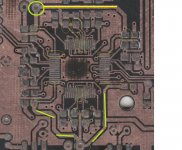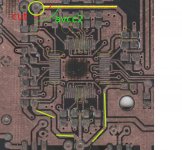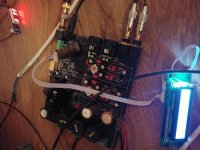I would like to thank this community for the wealth of knowledge it provides. I've always been an audiophile and this information has substantially added to my understanding of digital format and processing.
On the way is my new es9038pro which I will mod with various parts that have been recommended by members.
1. Opamps 1622 , 1611
2. VCC film caps
3. New clock
4. Ultra-low Noise DC Voltage regulator
5. New 400kva trans wt 70 prim. and 25 Volt sec. I had lying around.
I have prior knowledge and work experience in electrical that ive never really enjoyed and appreciated, but high end audio I would do free of charge. If I knew and understood I wouldn't destroy some expensive equipment. Thanks to this site for building my confidence.
On the way is my new es9038pro which I will mod with various parts that have been recommended by members.
1. Opamps 1622 , 1611
2. VCC film caps
3. New clock
4. Ultra-low Noise DC Voltage regulator
5. New 400kva trans wt 70 prim. and 25 Volt sec. I had lying around.
I have prior knowledge and work experience in electrical that ive never really enjoyed and appreciated, but high end audio I would do free of charge. If I knew and understood I wouldn't destroy some expensive equipment. Thanks to this site for building my confidence.
Last edited:
1. opa1622 is not a drop in. if you meant opa1612, then still for the current of 38pro kind of buffer might be required. for instance LME49600 or discrete emitter follower
2. VCC film caps won't help much unless you deal properly with above.
3. new clock and the dedicated LDO for it
4. low noise yes, but most importantly flat and low impedance in audio range
for the DIY in stereo 38pro is much worse choice than 28pro. if one fancy former nowadays Sabaj D5 for sort of 470bucks with HPA is just a steal. it does not make sense to mess with 38pro if your aim is to listen music, not to shell out the money or kill the time.
2. VCC film caps won't help much unless you deal properly with above.
3. new clock and the dedicated LDO for it
4. low noise yes, but most importantly flat and low impedance in audio range
for the DIY in stereo 38pro is much worse choice than 28pro. if one fancy former nowadays Sabaj D5 for sort of 470bucks with HPA is just a steal. it does not make sense to mess with 38pro if your aim is to listen music, not to shell out the money or kill the time.
I would like to thank this community for the wealth of knowledge it provides. I've always been an audiophile and this information has substantially added to my understanding of digital format and processing.
On the way is my new es9038pro which I will mod with various parts that have been recommended by members.
1. Opamps 1622 , 1611
2. VCC film caps
3. New clock
4. Ultra-low Noise DC Voltage regulator
5. New 400kva trans wt 70 prim. and 25 Volt sec. I had lying around.
I have prior knowledge and work experience in electrical that ive never really enjoyed and appreciated, but high end audio I would do free of charge. If I knew and understood I wouldn't destroy some expensive equipment. Thanks to this site for building my confidence.
1. opa1622 is not a drop in. if you meant opa1612, then still for the current of 38pro kind of buffer might be required. for instance LME49600 or discrete emitter follower...
ESS uses OPA1612 on ES9038PRO evaluation boards for everything. A buffer is only needed if wishing to sum channels before I/V conversion.
...for the DIY in stereo 38pro is much worse choice than 28pro.
I prefer '28PRO too. AVCC can be powered by two AD797 opamps acting as voltage regulators (heat sinks may be useful in that case). Much easier to make sound good than if trying to use LDOs.
ESS uses OPA1612 on ES9038PRO evaluation boards for everything. A buffer is only needed if wishing to sum channels before I/V.
Exactly, but those Chinese boards have all channels in parallel. Perhaps then half of the pins could be lifted for sake of better SQ
On order 4 ( LME49600 ) LDO.dedicated LDO for 1611, 1612, clock
I assume the position of LDO will be aft of voltage regulators ahead of opamps.
I assume the position of LDO will be aft of voltage regulators ahead of opamps.
On order 4 ( LME49600 ) LDO.dedicated LDO for 1611, 1612, clock
I assume the position of LDO will be aft of voltage regulators ahead of opamps.
LME49600 is not an LDO 😕
LDOs are good voltage regulators for clocks and for dac digital circuitry. Not necessarily so good for OPA1612, OPA1611.
Last edited:
what LDO would you recommend to power 1612, 1611?
And please explain at what location should this device be located? Would it be ideal to mount on a separate circuit board?
Transformer(9volts) to LDO(6volts) to 1612,1611
And please explain at what location should this device be located? Would it be ideal to mount on a separate circuit board?
Transformer(9volts) to LDO(6volts) to 1612,1611
what LDO would you recommend to power 1612, 1611?
And please explain at what location should this device be located? Would it be ideal to mount on a separate circuit board?
Transformer(9volts) to LDO(6volts) to 1612,1611
OPA1612, OPA1611 are best run using +-15v linear power supplies. As LDOs go, LT1083 seems pretty benign, but only works as a regulator for the +15v rail (at least in most cases). However, there are other voltage regulators that are not LDO types, and those regulators can be used too.
Also, if I may, I hope you will not feel offended if I ask you about your background in electronics?
It kind of sounds like some of this stuff is very new to you...
Commercial electrician, it's okay I'm not offended 🙂. But I I got a lot of time on my hands to break good equipment.
what LDO would you recommend to power 1612, 1611?
And please explain at what location should this device be located? Would it be ideal to mount on a separate circuit board?
Transformer(9volts) to LDO(6volts) to 1612,1611
there is no need for any LDOs for +/- opamp power. I suppose you have 317/337 regs for it, so leave it alone. later you may consider to add a bunch film caps what Mark recommends.
If that nice looking black board is the one I recall, I rejected it because both left and right AVCC supply traces were tied together somewhere in a multilayer board and impossible to separate.
I bought the same board (9038 version). Has anyone succeeded to separate the 2 AVCC?
Hi,
it's pretty easy to separate. The via is done by electrolytic cap pin near the microcontroller connector. I removed the cap, cut the two traces to the pin then bridge the two traces together. I'm testing a lt3042 reg as supply for avcc, as expected it's not good because of the high current transients, i've added a NPN transistor it is much better ( -15db better on 2nd harmonic)
Occip
it's pretty easy to separate. The via is done by electrolytic cap pin near the microcontroller connector. I removed the cap, cut the two traces to the pin then bridge the two traces together. I'm testing a lt3042 reg as supply for avcc, as expected it's not good because of the high current transients, i've added a NPN transistor it is much better ( -15db better on 2nd harmonic)
Occip
HI, can you please post a Photo - just to be sure?
Meanwhile I did also some investigation. on the attached Photo we can see the yellow and green marked L and R traces. I think if I drill the red marked whole with a bigger driller, than the connection Will be lost. possibly your solution is safer (not known what is inside).
Anyway, very strange board, I checked the sides and have noticed that it is 4 layer board - sticking is not visible for me. at all.
Regarding LT3042 - I was suspicious that the transient response is not sufficient enough. I started a thread - opa based Vref for AVCC - but that current is definitely not enough here. (it was planned for the q2m version)
Possibly the shunt regs has the best transient response - I Will do more investigation - getting exciting. This board is more promising than the q2m.
At least as I have seen nice planning, better starting point. much better initial sound. And keeping in mind what could be achieved with the q2m - I'm relly getting exciting. 🙂
Meanwhile I did also some investigation. on the attached Photo we can see the yellow and green marked L and R traces. I think if I drill the red marked whole with a bigger driller, than the connection Will be lost. possibly your solution is safer (not known what is inside).
Anyway, very strange board, I checked the sides and have noticed that it is 4 layer board - sticking is not visible for me. at all.
Regarding LT3042 - I was suspicious that the transient response is not sufficient enough. I started a thread - opa based Vref for AVCC - but that current is definitely not enough here. (it was planned for the q2m version)
Possibly the shunt regs has the best transient response - I Will do more investigation - getting exciting. This board is more promising than the q2m.
At least as I have seen nice planning, better starting point. much better initial sound. And keeping in mind what could be achieved with the q2m - I'm relly getting exciting. 🙂
Attachments
a first try.
Changed the power of the output stage to my former SALAS shunt reg.
Added some Strong caps. also. (nichicon audio)
To avcc added 2 1000uF silmic II + 2 10uF x7r - brute force.
49720 + opa27 ICs (i dont have 49710)
The sound is better, but very far from the q2m yet.
Changed the power of the output stage to my former SALAS shunt reg.
Added some Strong caps. also. (nichicon audio)
To avcc added 2 1000uF silmic II + 2 10uF x7r - brute force.
49720 + opa27 ICs (i dont have 49710)
The sound is better, but very far from the q2m yet.
Attachments
now I'm lasy and don't want to build something completly new, so I'm considering to use my LME49600 + 49720 based DC coupled Headphone amp for avcc (at least temporary)
Any experiences?
Any experiences?
I/V
OPA1611 has maximum 50mA output current.
the 9038PRO has 15mA / dac which is at least 60mA (4dac/left and right channels. - it seems not enough) - am'I mistaken?
OPA1611 has maximum 50mA output current.
the 9038PRO has 15mA / dac which is at least 60mA (4dac/left and right channels. - it seems not enough) - am'I mistaken?
I hope it's clearer with the picture 🙂
Adding a NPN to LT3042 seems to help a lot for current handling, I've ordered a LME49600 just to see if It can feed the avcc.
Thanks a lot for the help - I thought the same - but now it is sure. 🙂
As I mentioned I have a ready headphone amp with LME49600 - I Will try and report to you.
it is capable for 250mA/channel. 110MHz bandwidth.
I try this as 2nd try, while I can find a LowVoltage shunt reg circuit.
Last edited:
- Home
- Source & Line
- Digital Line Level
- China ES9018PRO ES9028PRO 9038PRO mods&upgrades


